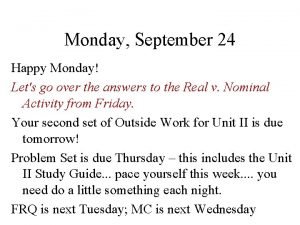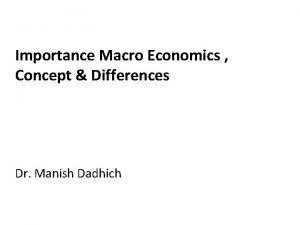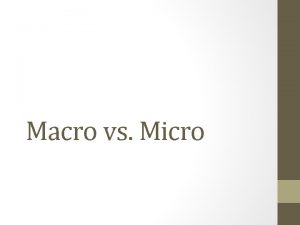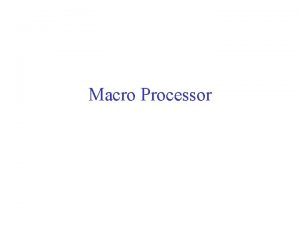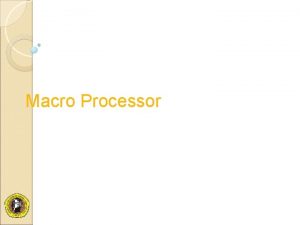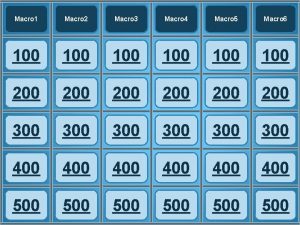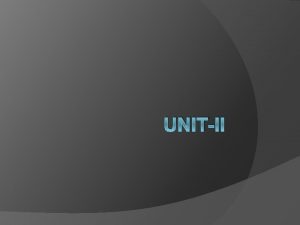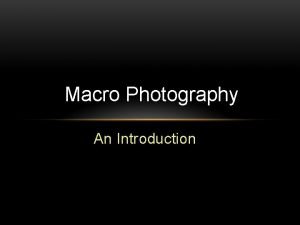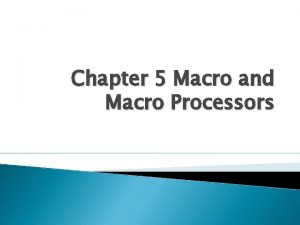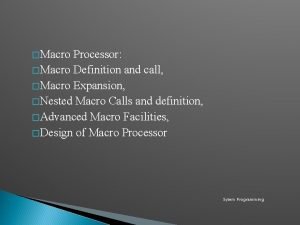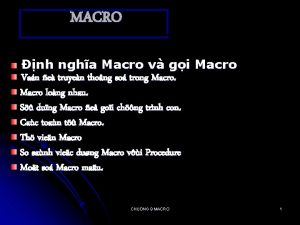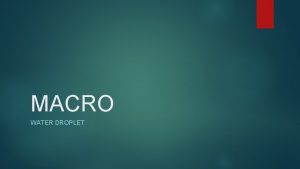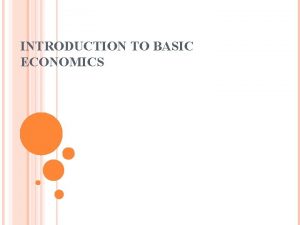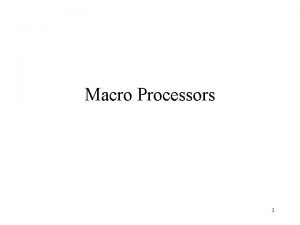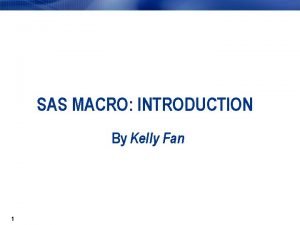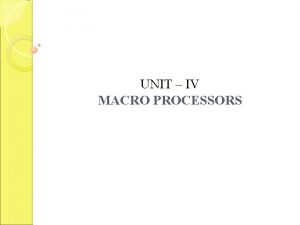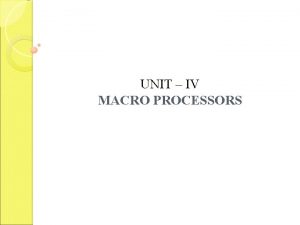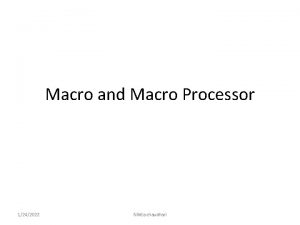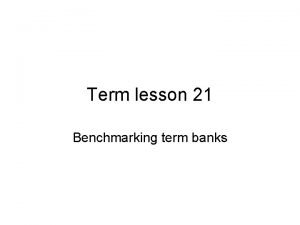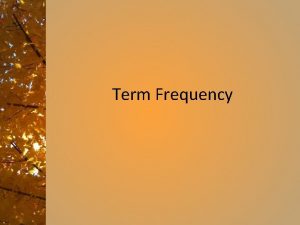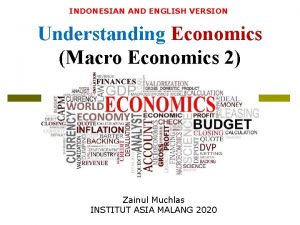INTRODUCTION TO MACRO ECONOMICS The term macro economics































- Slides: 31


INTRODUCTION TO MACRO ECONOMICS � � The term macro economics has been derived from the Greek word “makros” which means large. macro economics is that part of economic theory which studies the behaviour of aggregates of an economy or an economy as a whole. Eg : National Income total employment, Aggregate Demand, General Price etc. Origin and Growth The growth of macro economy can be studied under

� � 1. Classical Approach 2. Keynesian Approach Classical Approach The classical economist like Adam Smith , J S Mill etc believed that an economy can function without any government interference. According to them full employment is a normal feature of an economy or they assumed that an economy always functions at full employment. They believed that an economy is always in the state of equilibrium, there is neither overproduction nor underproduction


� � � KEYNESIAN APPROACH : Development of Keynesian macro economics analysis started with the great Depression of 1930’s. The great depression overruled the classical ideas of full employment and output of production. The classical economist could not find a solution to this problem. Macro economist as a separate branch emerged after the british economist JHON MAYNAND KEYNIS published his book “ The General Theory of Employment , Interest and Money “ In the year 1936. keynis observed that full employment is not always possible if the govt, must interfere to generate employment opprtunities.

JOHN KEYNESIAN

� � � Ø Ø Ø Ø According to keynesian theory equlibrium level could be established at a level lower than the fill employment level. He stressed on the rule of the Govt to undertakeninvestment to create employment opportunities. Features of Capitalism All the means of production and distributions are under the control of private is known as capitalism. Private ownership of factor of production’ Profit maximisation was a main motive Exploitation of workers by capitalist. Create two classes of people- the have and have nots. Create inequality in income and distribution. Central problems of economy is controlled by price mechanism; Production takes place for selling out put in the market.

Evalution of macro Economics In old days, the subject matter off economics was divided into three basic activities i. e. Production, consumption and investment(Capital formation). in this respect classical economists like – Adam smith, Malthus, Ricardo etc. studied economic parameters from the viewpoint of the economy as a whole. However , neo-classical economists like Marshall Pignou etc. attached greater significance to the study of Micro parameters and the trend continued till the World’s Great Depression of 1930. Therefore in order to eliminate this problem of depression Prof. Ragnar Frisch of oslo’s University , Norway , Divided the study of economics into two Branches in 1933, These were (a) Micro Economics (b) Macro economics. After that in 1936 , with the publication of J. M. Keynes Book- ‘The General Theory of Employment , interest and money’. Study of two different branches once again assumed greater significance.

Inflation and deflation since 1929: This figure shows the annual rate of change in the Consumer Price Index. After the deflation of the early 1930 s, the U. S. economy has consistently had inflation. But the high inflation rates of the 1970 s and early 1980 s have come down, and the economy these days is not too far from price stability. 9

The Great Depression precipitated a thorough rethinking of macroeconomics which gave rise to modern macroeconomics. 10

Scope of Macro Economics Or Issues/Problems of Macro Economics Macro economics largely deals with the following areas of study: 1. Concept & measurement of National Income : 2. Determination of income and employment : 3. Money & banking : 4. Government Budget & the economy OR Aggregate saving & investment 5. Theory of General price level: 6. Theory of economic growth : 7. Theory of International Trade : 8. Output of firm:

Uses Macro economics Importance Or uses of Macro Economics v Helpful in formulation of economic policy : 1. Study of fluctuations in economy : (income output, expenditure, saving, investment etc. ) 3. Helpful in comparison : 4. Measurement of economic development : 5. Estimation of welfare : 6. Study of inflation & deflation : explained further

Inflation and Deflation Ø Ø Ø A rising aggregate price level is inflation. A falling aggregate price level is deflation. The inflation rate is the annual percent change in the aggregate price level. The economy has price stability when the aggregate price level is changing only slowly. Because inflation and deflation cause problems, price stability is generally desirable. In reality, the inflation rate has mainly been positive for decades, though we are not too far from price stability today. 13

Micro economics Macroeconomics 1. It is study of individual economic units 1. It is study of economy as a whole and of an economy its aggregates. 2. It deals with individual income, 2. It deals with aggregates like national individual prices and individual outputs income, general price level and national etc. , output etc. , 3. Its central problem is price 3. Its central problem is determination of determination and allocation of level of income and employment. resources. 4. Its main tools are aggregate demand 4. Its main tools are demand supply and aggregate supply of the economy as of particular commodity/factor. a whole. 5. It explains how resources are 5. It explains how productive capacity and allocated to different lines of national income grow over time. production and how national income is 6. It is concerned with the determination distributed. of equilibrium level of income and 6. It discusses how equilibrium of a employment. consumer, a producer or an industry is 7. Income is the major determinant of attained Macro economic problems 7. Price is the main determinant of Micro 8. Examples are National Income, economic problems National savings, General price level, 8. Examples are Individual income, national output, Aggregate consumption, Savings Unit Individual Prices, poverty, aggregate Economic Meansfirms. – those individual orexpenditure, institutions which take economic decisions. output, Individual consumption employment etc. ,

Macroeconomics vs. Microeconomics Ø Microeconomics focuses on how decisions are made by individuals and firms and the consequences of those decisions. ØEx. : How much it would cost for a university or college to offer a new course – the cost of the instructor’s salary, the classroom facilities, the class materials, and so on. Having determined the cost, the school can then decide whether or not to offer the course by weighing the costs and benefits. Ø Macroeconomics examines the aggregate behavior of the economy – how the actions of all the individuals and firms in the economy interact to produce a particular level of economic performance as a whole. ØEx. : Overall level of prices in the economy – how high or how low they are relative to prices last year – rather than the price of a particular good or service. 15

Four Principal Ways that Macroeconomics Differs from Microeconomics: ØIn macroeconomics, the behavior of the whole macroe conomy is, indeed, greater than the sum of individual actions and market outcomes. ØMacroeconomics is widely viewed as providing a rationale for continual government intervention to manage short-term fluctuations and adverse events in the economy. Ø fiscal policy, control of government spending and taxation, and Ø monetary policy, control over interest rates and the quantity of money in circulation 16

Four Principal Ways that Macroeconomics Differs from Microeconomics: ØMacroeconomics is the study of long-run growth: What factors lead to a higher long-run growth rate? And are there government policies capable of increasing the long-run growth rate? ØA distinctive feature of modern macroeconomics is that both its theory and policy implementation focus on economic aggregates -- economic measures that summarize data across many different markets for goods, services, workers and assets. 17

The Business Cycle ØThe business cycle is the short-run alternation between economic downturns, recessions, and economic upturns, expansions. ØA depression is a very deep and prolonged downturn. ØRecessions are periods of economic downturns when output and employment are falling. ØExpansions, or “recoveries”, are periods of economic upturns when output and employment are rising. 18

Four sectors of the economy 1. Household sectors (H) 2. Firms/producer sector(F) 3. Government sector (G) 4. The external sector (X-M) : OR Macro economics

Ø Ø Ø Ø HOUSE HOLDS (H) It Includes those who supply factors of production to the firms and to buy the goods and services from the firms FIRMS (F) These are economic units which produce goods and services and employ factors of production from the household GOVRNMENT (G) They maintain law and order and work for the economic wellbeing of the citizen EXTERNAL(X-M) The external sector or the foreign sector refers to the economic transactions of a country with the rest of the world.

CIRCULAR FLOW OF INCOME � � � Circular flow of income refers to the cycle of generation of income. Its distribution among factors of productions and its circulation from household to production units. It is the flow of money , income , goods and services across different sectors of the economy. In every economy : Three activities 1. Production 2. Generation of Income 3. Expenditure

Significance of circular flow � 1. Knowledge of interdependence : � (Between producers and households) 2. Size of national income : Circular flow determines the size of national income. � � � 3. Level of economic activity : 4. Injection and leakages : injection- investment, exports etc leakages – saving, tax and imports

TYPES OF CIRCULAR FLOW � � REAL FLOW/PRODUCT FLOW It refers to the flow of factor services from households to firms and the corresponding flow of goods and services from firm to households

� As shown above , households provide factor services to the firms and as services to the households. As there is no involvement of money , such a flow is known as real flow. � MONEY FLOW/Nominal Flow (Income Flow) � Money flow refers to the flow of factor payments from firms to households and corresponding flow of consumption expenditure on goods and services it is also known as Nominal Flow

FACTOR PAYMENTS(RENT, WAGES ETC) FIRMS HOUSEHOLDS FINISHED GOODS

� As shown above , firms make factor payments to households for their factor services, Households spend this income on purchase of goods and services produced by the firms. As it involves exchange of money between the two secters, such a firm is known as money flow

Circular Flow of Income in a Two Sector Economy � � A single economy assumes the existence of only two sectors-Households and Firms. Households are the owners of factors of production and consumers of goods and services produced by the firms. It is in the term of a closed economy where there is no government sector and foreign sector. Households supply factor services only to terms and firms produce goods services only for households. Households receive factor income from firms and spend the entire amount on goods and services from firms. The circular flow is shown in the following diagram


� Ø Ø Ø Conclutions of circular flow in two sector economy Total production - Total consumption Factor payments - Factor Income Consumption Expenditure – Factor Income Ø STOCK AND FLOW Stock and flow are variable which are frequently used in macro economics. A variable is a measurable quantity which changes or varies its values. Some macro variables are related to stock while others are flow variables.


The End
 Econmovies episode 6 worksheet answers
Econmovies episode 6 worksheet answers What is conditional macro expansion
What is conditional macro expansion Examples of microeconomics
Examples of microeconomics Importance of macro economics
Importance of macro economics Micro and macro economics venn diagram
Micro and macro economics venn diagram Micro macro economics
Micro macro economics Managerial economics chapter 1
Managerial economics chapter 1 Short term planning and long term planning
Short term planning and long term planning Term-to-term rule
Term-to-term rule Long term memory vs short term memory
Long term memory vs short term memory Nth term of a sequence
Nth term of a sequence Example of short term human resources
Example of short term human resources Position-to-term
Position-to-term Difference between long term and short term liabilities
Difference between long term and short term liabilities Difference between long term and short term liabilities
Difference between long term and short term liabilities Minterm and maxterm
Minterm and maxterm Term to term rule example
Term to term rule example Term to term rule
Term to term rule Short term goals examples
Short term goals examples Short term and long term cash forecasting
Short term and long term cash forecasting Hình ảnh bộ gõ cơ thể búng tay
Hình ảnh bộ gõ cơ thể búng tay Frameset trong html5
Frameset trong html5 Bổ thể
Bổ thể Tỉ lệ cơ thể trẻ em
Tỉ lệ cơ thể trẻ em Voi kéo gỗ như thế nào
Voi kéo gỗ như thế nào Tư thế worm breton
Tư thế worm breton Chúa sống lại
Chúa sống lại Các môn thể thao bắt đầu bằng từ đua
Các môn thể thao bắt đầu bằng từ đua Thế nào là hệ số cao nhất
Thế nào là hệ số cao nhất Các châu lục và đại dương trên thế giới
Các châu lục và đại dương trên thế giới Cong thức tính động năng
Cong thức tính động năng Trời xanh đây là của chúng ta thể thơ
Trời xanh đây là của chúng ta thể thơ
